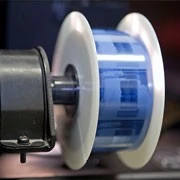Outsource Microfilm Scanning and Conversion

For over 100 years, newspaper corporations and major businesses have used microfilms as the primary way to store and back up critical records, print media etc. For many years in fact, very few archival methods came close to replicating the accuracy of microfilms, while backing up paper based records. The most commonly used microfilm formats are -
- 16mm film roll - A normal 16mm roll can contain between 2000-5000 images, and is generally used by governmental agencies and corporations for storing employment records, contractual records etc.
- 35mm film roll - This type of film is often used to store large drawings and engineering blueprints, and is used by architectural firms, publishing houses etc.
Over the past 25 years, we have seen groundbreaking improvements in technology and e-media, and with the proliferation of CD, DVD, Hard Drives, and now cloud technology, people finally have access to various means and methods to store and digitize their media and information.
The Push towards Microfilm Scanning
Utilizing microfilms to archive documents for future use has its own demerits. The biggest downside is that highly specialized and costly equipment is required to view, as well as print microfilm records. Add to that the fact that it is very difficult to access a specific document on a microfilm, and that only one person can use the film at a time, and suddenly the microfilming technique begins to look very ancient as compared to today's technology.
In this day and age, there is a necessity for storage media which is easy to use, allows fast access and is easily shareable. Therefore, there is an increasing push towards finding convenient methods to scan and digitize microfilms.
By scanning and converting the microfilm into an electronic format, the information becomes versatile and readily accessible. This data can also be shared among multiple users. At the same time, businesses can empty up valuable space which was used to store microfilm rolls.
Some other benefits of microfilm scanning include -
- Complete indexing of source material e.g. By name, date, document number etc.
- Ability to store color images separately
- Remote access capability
- Linking and publishing capability through different formats (web, PDF, CD-ROM etc.)
The Way Forward for Microfilm Digitization
There is a reason why, even with gradual technological innovations, microfilm is likely to remain the standard for archiving requirements. It is a well-accepted and durable product, which can produce a true, close-to-source facsimile of a document. Microfilms being used currently for archiving requirements have an image quality of over 2000dpi, as compared to the most common laser printers which have an image quality of only 600-1000dpi, with very few expensive options going up to 2400dpi.
At the same time, the benefits of scanning and digitizing microfilms are numerous, and therefore, probably the most ideal solution would be to combine both technologies. If created and archived in appropriate storage conditions, microfilms have a life expectancy of 500 years. At the same time, by scanning and creating the films' digital version, it can be easily stored on DVD's or other storage media, and can also be shared and viewed over the internet etc. This procedure guarantees that the original film always remains safe and secure.
As part of our extensive data entry services, Outsource2india offers professional grade OCR services, which can help you minimize data entry errors and handle high-volume workloads.
Contact us now for specialized document digitizing services, our experts will be glad to assist you.
Get a FREE QUOTE!
Decide in 24 hours whether outsourcing will work for you.
Have specific requirements? Email us at: ![]()
-
 O2I's Data Management Services to A Funding Company in The US Led to Increased Business Closures
O2I's Data Management Services to A Funding Company in The US Led to Increased Business Closures
-
 Optimizing Purchase Order Processing for a Leading IT Solutions Provider
Optimizing Purchase Order Processing for a Leading IT Solutions Provider
-
 Outsource2india Provided Data Extraction to an Auckland-based Client
Outsource2india Provided Data Extraction to an Auckland-based Client
-
 Outsource2india Provided Scanning & Data Entry to a UK-based Software Firm
Outsource2india Provided Scanning & Data Entry to a UK-based Software Firm
-
 Outsource2india Provided PDF to Excel Data Conversion for a Florida-based Professor
Outsource2india Provided PDF to Excel Data Conversion for a Florida-based Professor -
 Outsource2india Provided e-commerce Data Entry to Bike Accessories Seller
Outsource2india Provided e-commerce Data Entry to Bike Accessories Seller
Data Entry Services in Philippines Choose us for highly efficient, accurate, and cost-effective data entry services Read More
Microfilm Scanning Conversion FAQs
-
Can you digitize microfilm?
Yes, you can digitize microfilm. You can transfer the film, which is on sheets or rolls, into digital images, thereby eliminating the need for microfilm hardware to read your rolls.
-
What is the difference between microfilm and microfiche?
Microfilm is a reel of 16mm or 35mm film whereas Microfiche refers to a flat sheet of images.
-
What is a microfilm printer?
Microfilm printers are designed to view and print microforms. They send microfilm images to a PC and utilize the host PC's resources to view, print, and save the image as a digital file.













